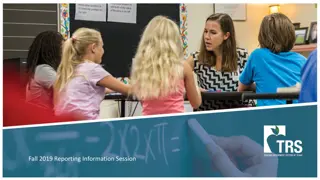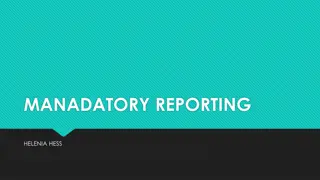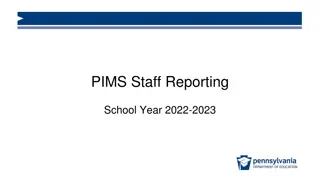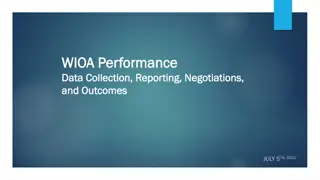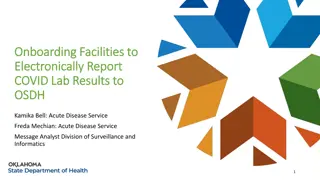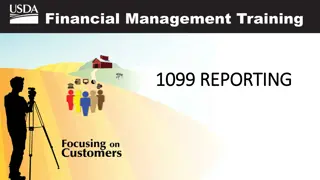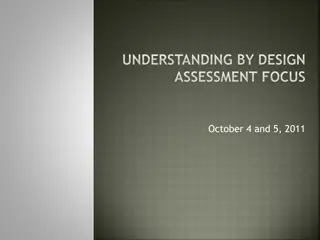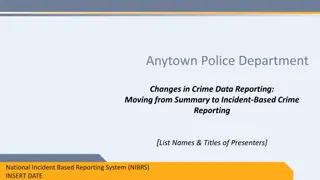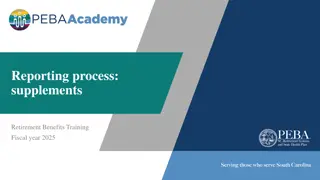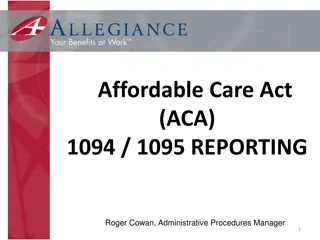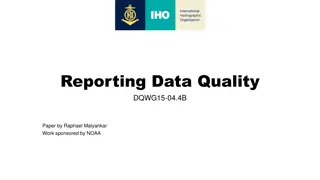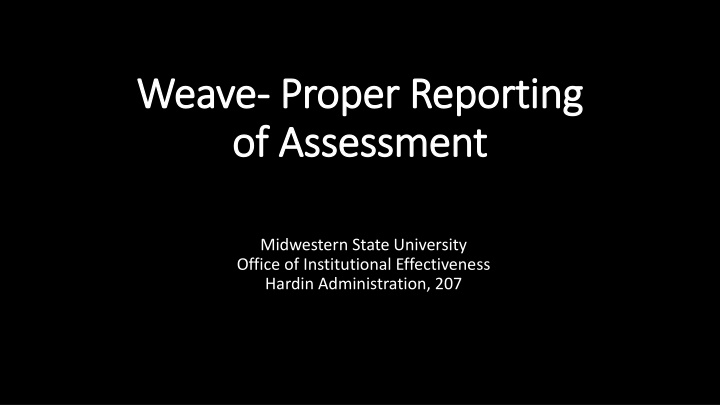
Effective Assessment Reporting at Midwestern State University
Discover how to efficiently report assessment data at Midwestern State University using the Weave platform. Follow a step-by-step guide for proper reporting, status updates, mission statement inputs, and assessment narratives. Improve your reporting process with these detailed instructions.
Download Presentation

Please find below an Image/Link to download the presentation.
The content on the website is provided AS IS for your information and personal use only. It may not be sold, licensed, or shared on other websites without obtaining consent from the author. If you encounter any issues during the download, it is possible that the publisher has removed the file from their server.
You are allowed to download the files provided on this website for personal or commercial use, subject to the condition that they are used lawfully. All files are the property of their respective owners.
The content on the website is provided AS IS for your information and personal use only. It may not be sold, licensed, or shared on other websites without obtaining consent from the author.
E N D
Presentation Transcript
Weave Weave- - Proper Reporting Proper Reporting of Assessment of Assessment Midwestern State University Office of Institutional Effectiveness Hardin Administration, 207
Logging In https://app.weaveeducation.com/login/ 1) Click on Access Weave using your institution s sign-on below the Log In button
Logging In 2) Type in mwsuand hit the Continue button
Logging In 3) Underneath the Log In button it should now say You are going to sign in using Midwestern State University authentication 4) Log in using your MSU computer login
Status 1) Underneath where it says Status, click on the drop down menu that says Not Started
Status 2) The drop down menu should contain the choices that say Not Started, In Progress, Internal Review, and Complete
Status 3) Choose the option that says In Progress, which will let everyone know that you are working on entering in all of your information to Weave
Mission Statement 1) Where it says Mission Statement, click the to expand the section
Mission Statement 2) In the empty box is where you will be able type in your mission statement
Mission Statement 3) Once you are done entering your information, click anywhere outside of the text box, and it should show what you entered *This is true for every text box throughout the assessment plan, so make sure to do this before exiting the page/the browser or else the information will not save
Assessment Narrative 1) Where it says Assessment Narrative, Click the to expand the section 2) Click on the box where it says Enter text
Assessment Narrative 3) In the empty box is where you will be able type in your assessment narrative
Assessment Narrative What is the assessment narrative? The assessment narrative is where you highlight the important factors that contributed to the assessment cycle within the past year. It is written as a one to two page summary that discusses not only how assessment plays a role in the department, but also how it is meaningful and being used to improve upon student learning or services being provided. It includes the following main ideas: Process: Results: Challenges: Positives: Collaboration: Reflections: What did the assessment process look like throughout the year? What were some of the main themes and discoveries from the year? What were some challenges the department faced during the year? What were some positives from the year? How did the department work together towards continuous improvement throughout the year? What is there to reflect on from the year?
Goals 1) Where it says Goals, click the + to add a section 2) It will bring up a section that says 1 Goals
Goals 3) In the empty box next to 1 Goals, type in See Outcomes Below *We do not require goals at MSU, and instead focus on the outcomes, because we believe that continuous improvement for every department and program is the ultimate goal
Outcomes 1) Where it says Learning Outcomes, click the + to add a section 2) It will give you the option to choose Program Level or Institutional Level, and you should click on Program Level
Outcomes 3) There should be an empty box next to 1.1 Learning Outcomes that says Enter Text
Outcomes 4) In the empty box next to 1.1 Learning Outcomes, type in Outcome 1 5) Click on the box where it says Enter text below Description to enter in your outcome
Outcomes 5) Type in your outcome below the Description section
Outcomes What are student learning outcomes? SLO s are used by those who work directly with students, or for departments who provide services to students. They are measurable and meaningful, as well as specific and realistic, and there needs to be a minimum of three. Some questions to keep in mind when developing SLO s include, but are not limited to: 1) What do you want students to learn? 2) What do you want students to gain from the program? What are functional outcomes? Functional outcomes are used by those who do not work directly with students. Academic programs can include functional outcomes in their assessment plan, but they must be in addition to, and not in place of, the three required SLO s. Functional outcomes are measurable and meaningful, as well as specific and realistic, and there needs to be a minimum of three. Some questions to keep in mind when developing functional outcomes include, but are not limited to: 1) What kind of services do you strive to offer? 2) What is the purpose of the services you provide?
Outcomes How do I write student learning outcomes (SLO s)? 1) Answer the following questions: - What do you want students to learn? - What do you want students to gain from the program? 2) Focus on what you want the student to be able to demonstrate or know upon completion of the program. 3) Consider how this information can be expressed through knowledge, skills, attitudes, or values. 4) Answer the following question: - How will you know when the students have learned what you want them to know? 5) Draft your outcome by utilizing action verbs.
Outcomes How do I write functional outcomes? 1) Answer the following questions: - What kind of services do you strive to offer? - What is the purpose of the services you provide? 2) Decide on what you want the focus of your assessment to be. The following are some examples: - Reducing production time - Reducing errors - Increasing efficiency - Increasing accuracy - Increasing paperless efforts - Decreasing use of paper - Compliance with standards - Compliance with regulation - Satisfaction of clients 3) Draft your outcome by utilizing action verbs.
Blooms Taxonomy, Learning In Action KNOWLEDGE COMPREHENSION APPLICATION ANALYSIS SYNTHESIS EVALUATION count define describe draw identify label list match name outline point quote read recall recite recognize record repeat reproduce select state write associate compute convert defend discuss distinguish estimate explain extend extrapolate generalize give example infer paraphrase predict rewrite summarize add apply calculate change classify complete compute demonstrate discover divide examine graph interpolate interpret manipulate modify operate prepare produce show solve subtract translate use analyze arrange breakdown combine design detect develop diagram differentiate discriminate illustrate infer outline point out relate select separate subdivide utilize categorize combine compile compose create derive design devise explain generate group integrate modify order organize plan prescribe propose rearrange reconstruct relate reorganize revise rewrite summarize specify transform assess compare conclude contrast criticize critique determine grade interpret judge justify measure rank support test The chart above was borrowed and updated from the Office of Assessment at Kansas State University: https://www.k-state.edu/assessment/toolkit/outcomes/action.html
Measures 1) Where it says Measures, click the + to add a section 2) It will bring up a section that says 1.1.1 Measures
Measures 3) In the empty box next to Measures, type in what type of measure you used (Ex: Project, Rubric, etc.) 4) Under Source of Evidence is where you will pick what type of Measure you chose
Measures 5) Under Description is where you will give more details about the measure you chose *The Methodology area is optional
Measures What are measures? There are two types of measures, including direct and indirect. Direct measures are where students demonstrate the learned knowledge/skills, and indirect are where students reflect on the learning. Each SLO needs a minimum of two measures, including one direct measure and one indirect measure. It is highly recommended that each functional outcome has a minimum of two measures as well. There are four things to keep in mind when developing measures, including the four W s: Who: Who was the population being measured? What: What tool was used to measure? When: When was this measure being done? Where: Where was this measure being done?
Targets 1) Where it says Target, click the + to add a section 2) It will bring up a section that says 1.1.1.1
Targets 3) Click underneath Status where it currently says Not Met 4) Your options to choose from will be Not Set, Nothing Entered, Not Reported This Period, Not Met, Met, and Exceeded
Targets 5) Under Description is where you will give us an overall description of what your target was 6) Under Target is where you will put your actual target goal 7) Under Findings is where you will put in your findings and results from the data and information you collected
Targets 8) Under Narrative is where you will give more details about the findings 9) If you click on the box underneath Improvement Type where it says None Set, there will be a lot of different choices to choose from, so pick the one that best reflects your findings
Targets 10) Under Improvements Achieved is where you will describe more details about the improvements, if there were any
Targets What should you keep in mind when choosing targets? For student learning outcomes (SLO) s, what is the desirable level of performance for students? For functional outcomes, what is the desirable level of performance for specific tasks and programs? For both student learning outcomes (SLO s) and functional outcomes, try to use specific percentages or numbers when possible.
Action Plans 1) If your target was not met, then click on Action Plans + that is above the Measures section to add an action plan
Action Plans 2) Under description is where you provide a summary for your action plan 3) Budget Source is not required, but you should fill in the Budget Source, Amount, Due Date, and Status if any steps in your action plan involve the department s or program s budget
Action Plans 4) To add individual steps to your action plan, click on + Add Action Item for each one 5) For each action item, it will show the date it was created, and then allow you to pick the status from the dropdown menu that includes Planned, Complete, and In Progress
Action Plans What are action plans? Action plans are based on findings, and they are only required for targets that were not met. Action plans describe detailed steps that will be taken to improve the program or services being provided, as well as when this action will be implemented. The action plan also discusses how the target will stay the same or change for the future year, based on what the results were. If a target has consistently not been met for multiple years in a row, it is recommended to reexamine if this target is realistic or not, as well as the themes and patterns the data might show of why it has not been met. If a target has consistently been met or exceeded for multiple years in a row, changing or raising the target is recommended, or even reexamining if a new outcome should replace it if the overall goal of that outcome has been met. If the assessment plan has action plans from the previous year, they should be updated to reflect if they are completed or still in progress.
Attachments 1) To upload attachments to your assessment plan, scroll down to the bottom 2) You can either click and drag your attachments directly from your computer into the box that says so, or you can click on browse for files and upload attachments from there
Attachments Do I have to include attachments? Attachments are not required, but they do a great job at supplementing the assessment process and the data that is being reported. The peer review and IE office feedback will always be attached from the previous year. Attachments can include, but are not limited to: - Examples of data that was collected - Rubrics - Student work - Meeting minutes - Findings
Status 1) Underneath where it says Status, click on the drop down menu that says In Progress 2) The drop down menu should contain the choices that say Not Started, In Progress, Internal Review, and Complete
Status 3) Choose the option that says Internal Review, which will let everyone know that your assessment plan is submitted and ready to be reviewed
Questions or Concerns? Contact: Dr. Eboneigh Harris Director of Planning and Assessment eboneigh.harris@msutexas.edu X4567 Stephanie Mescher Assessment Specialist stephanie.mescher@msutexas.edu x4342



